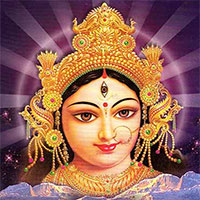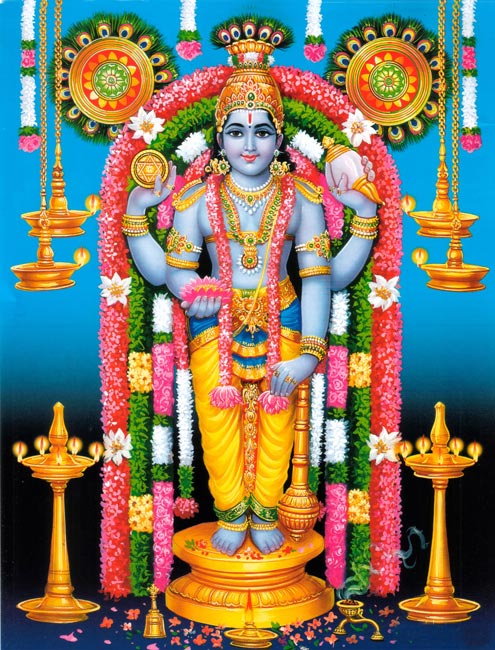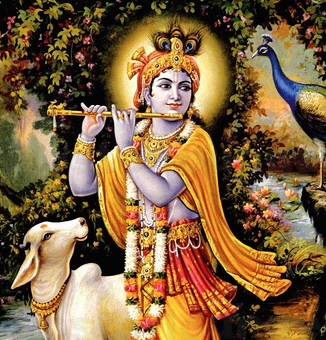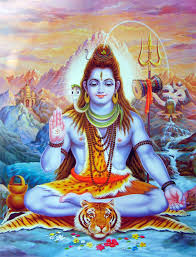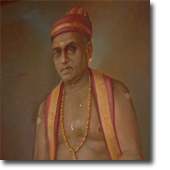
COMPOSER Irayimman Thampi (Iravivarman Thampi) |
|
|||||||||||||
|
Irayimman Thampi was born in Royal family of Travancore as Ravi Varman Thampi to KeraLa Varma TamprAn of ShErttalai palace, and PArvati PiLLa Tangacci, daughter of Makairam Thirunal Ravivarma.. As it was the prevailing custom to name the eldest son by the grandfather’s name, Thampi’s real name was Ravi varman, which later became Iravi varman, and finally Irayimman, as he was affectionately called. Even as a young boy, Thampi’s aptitude towards music and poetry was very deep and, under the royal patronage, he could develop his various talents. He did not have any formal “guru” for music, and his abilities were mostly self-cultivated. He wrote his first poem when he was fourteen and dedicated it to Karthika Thirunal Dharmaraja of Travancore. Since then he occupied an enviable position in the Travancore court. Irayimman Thampi was already thirty one years of age when Swathi Thirunal Maharaja was born. His most famous lullaby Omanathinkal Kidavo – set in R?ga Neelambari was written for the sake of the ruling Queen RANi gaurI lAkSmI bAi, to put to sleep none other that the newborn Swati Thirunal Maharaja. It is to be noted that there is no mention of the word “sleep” anywhere in this lullaby.This song also praises the birth of much needed male child into the royal dynasty which was slowly getting into the clutches of British.
He was married to the daughter of his maternal uncle and they had a girl child, Kutti Kunju Thankachi who was also a gifted composer and perhaps her father’s only disciple. Thampi had the privilege of enjoying the liberal patronage and protection of four kings Dharmaraja, Balarama Varma, Swathi Thirunal and Uthram Thirunal and two Queens Gouri Parvathy Bai and Gouri Lakshmi Bai . He was very closely associated with Vadivelu of the Thanjavur Quartette and Palghat Parameswara Bhagavathar. Maharaja Swati Tirunal made him the “Aasthana Kavi” and awarded him the `Virasinghala,’ a golden chain that was the highest honour at that time in Travancore.
There existed a healthy competition in composing songs between Swati Thirunal and Thampi, who was affectionately addressed as Thampi Maman by Swati Thirunal. Swathi Thirunal’s famous lyrics ‘Panchabanan thannudei…..’ and Thampi’s “Prananadhanenikku Nalkiya…..” were the results of such competitions
Thampi has composed songs on several gods/goddesses of nearby temples, namely Lord padmAnabha of Tiruvanantapuram, shrI krSNa (of guruvAyUr temple, ambalapuzha temple, and neyyAttinkara), shiva, dEvi (ARRingal tiruvARaTTu bhagavati, paLLiyaRa bhAgavati, and kollattu cuRRumala shri pArvati). He has also sung in praise of the queens, vancIshvari RANi gaurI pArvati bAi, and RANi rukmiNi bAi (sister of Swati Thirunal).
Among the compositions of Thampi, the kriti “karuNa ceyvAn entu sAhasam kriSNA” on Lord guruvAyUrappan is very popular and frequently heard in concerts. Though composed originally in “shrI rAgam”, the musician Chembai VaidyanAtha BhAgavathr used to sing it in yadukula kAmbhOji, and it is equally pleasing. Among the many pada varNams Thampi composed, one in punnAgavarALi (“hAsAlOkE dhanya jAtA”) is a rare treasure, but unfortunately, it is not available in complete form due to the absence of ciTTa svarams and svara sAhityams. Thampi used the mudra “padmanabha” in his compositions. “bhOgIndra shAyinam” is often attributed to Swati Thirunal due to the presence of the mudra “padmanAbha”, but it was found in a hand-written manuscript of Thampi. The rAgam was dhanyAsi. In his work, “kErala sangItam”, the author V. Madhavan Nair attributes it to Thampi. Thampi has composed songs in all rasas. His kritis contain numerous and lengthy caraNam lines. Perhaps, he meant these songs not only to be sung in concert platforms, but as scholarly poems too, to be enjoyed by the readers. He has employed rakti rAgams like kAmbhOji, kalyANi, husEni, dhanyAshi, sAvEri, rItigauLa, mOhanam, bhairavi, madhyamAvati etc, as well as some rare rAgams like mAnji, jingaLa, kakubha, indIsha. The last two are very rare. The song “surabAsha hara” by Thampi is in kakubha, perhaps a janyam of mAyamAlavagauLa . The padam “ArODu colvan azhaluLLatellAm” is in indIsha rAgam, which was once a populart rAgam for the tuLLal songs of kuncan nambiaAr.The usage of dvitIyAkSara prAsam (rhyming in the second letter of each line), known as Edhugai in Tamil is found in most of Thampi’s musical and poetical works.
According to T. Lakshmanan Pillai, Irayimman Thampi has to his credit more that 500 compositions. But, only few of those compositions have survived, which include 39 keerthanams, 5 varNams, 23 padams and a few ATTAkkatha songs. Of the 39 keerthanams, 29 are in Sanskrit, and the remaining in malayALam.
While residing in an kizhakkE maDam, an almost-torn down old house, Irayimman Thampi wrotea verse in maNipravALam, employing shlESham (double meaning – comparing his old house to the epic bhAgavatam), and submitted it to MaharAjA Swati Thirunal .
Oh King! My house is very very old (purANam) just like the Epic bhAgavata purANam; those who glance through it will have immediate detachment (virakti), just like the feeling you get when you read the Epic; but there is one small difference — my house has no arttham (monetary value) whereas the epic is deep in arttham.
The King was immensely pleased with this poem, and immediately ordered the renovation of the house, to the fullest satisfaction of Irayimman.
On another occasion, there was a minor love-quarrel between Swati Thirunal and the wife, and it lasted for a few days. Irayimman wrote an appropriate love song, “prAnanAthanenikku nalkiya” with shrigAra rasam in kAmbhOji for the queen, and requested the her to sung it loudly, when the King was passing through. On hearing the song, the King understood everything, and there was complete reconciliation. This particular work of Thampi is one of the most beautiful shringAra padams available in MalayALam. The composer, who penned the monumental toTTil pATTu (cradle lullaby) for Swati Thirunal, lived long enough to write a Charama shlOka (elegy) also for Swati Thirunal who died in 1846. Thampi lived another 16 years and died in the year 1856.
|
||||||||||||||





